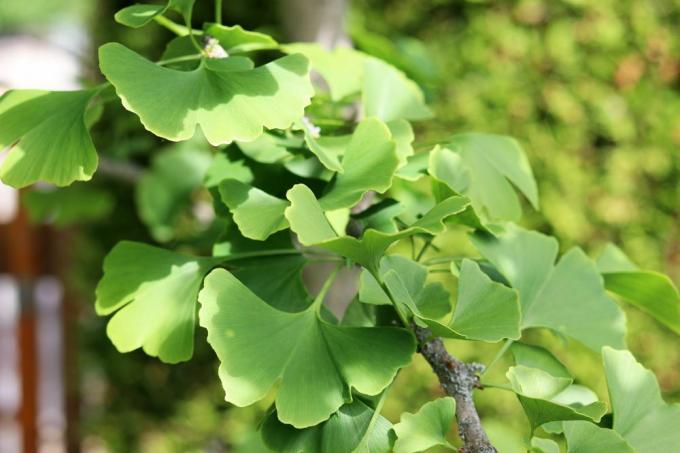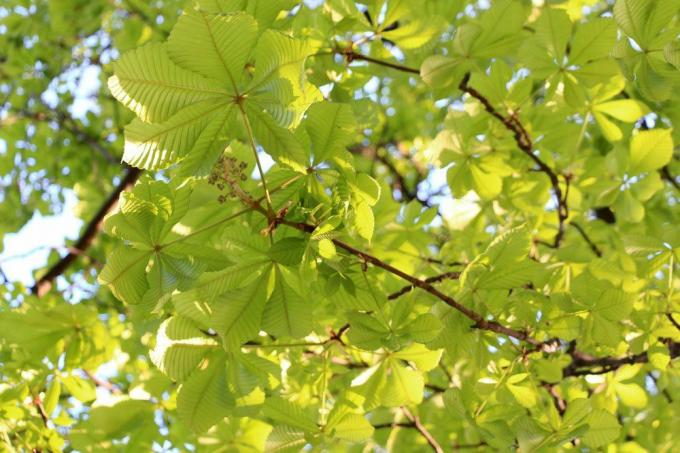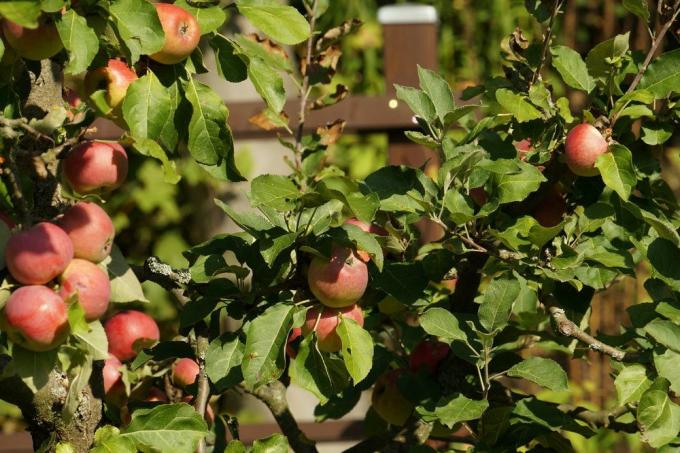
table of contents
- Tub planting
- Pure ornamental trees
- Deciduous trees
- Fruit trees
- Conifers
- Pot planting
- Planting instructions
Trees stand for vitality and stability. They not only thrive in the garden, but also in flower pots. However, only small and weak dwarf trees are suitable for this. They impress less with their floral decorations than with a variety of shapes and colors of their leaves and, depending on the type of tree, with fruit hangings. You can choose between ornamental, fruit, deciduous and coniferous trees. Even in a bucket, trees can reach an impressive age of several decades, provided that a few things are taken into account.
Tub planting
Trees suitable for buckets
When choosing suitable trees for the bucket, not only the height and location, but also the winter hardiness often play a decisive role. Trees with a good winter hardiness can stand outdoors all year round, while partially hardy Specimens can only tolerate minimal freezing temperatures and only overwinter outside in mild locations can. For exotic or Mediterranean plants lack frost resistance completely, so that they have to be housed in a frost-free area throughout the winter.
Pure ornamental trees
Angel's Trumpet (Brugmansia)
With its large, white, yellow, red, orange or multi-colored, funnel-shaped flowers, the angel's trumpet is one of the most popular trees for the flower pot. They are fast-growing and reach heights of between 100 and 300 cm. Flowering time is from July to September. The angel's trumpet should not stand in pots that are too small and overwinter frost-free.
Tip: The angel's trumpet is highly poisonous in all parts of the plant.

Japanese mini cherry 'Kojou-no-mai'
This ornamental cherry grows very compactly and reaches heights of 140 to 160 cm in the balcony tub. The white, pale pink flowers appear from mid-March to early May. Their delicate, zigzag-shaped, twisted branches make these trees a real eye-catcher even in the leafless season.
Ornamental apple 'Tina' Malus 'Tina'
This fruity dwarf presents itself in May with an abundance of flowers. The snow-white, bowl-shaped flowers develop from red buds, transforming the dwarf tree into a true flowering dream in May. The dwarf tree is up to 150 cm high and grows a maximum of 250 cm in width. After flowering, small, bright red, inedible ornamental apples develop.
Red dogwood Cornus sanguinea 'Winter Beauty'
This summer-green wood impresses with its white flowers and especially the medium-green foliage, bronze-colored when budding and orange-yellow in autumn. The black, slightly poisonous berries later ripen from the flowers. Its branches are orange-yellow in winter and reddish in the upper area. This small tree grows wide and upright, with a height of almost 200 cm and is easy to cut.
Almond tree (Prunus triloba)
The pink, double flowers of this densely branched ornamental tree usually appear before the leaves shoot, in April / May and sit close to the branches. With heights of up to 200 cm, the almond tree is the miniature version of the Japanese cherry blossom, but it has the same as the real one Almond tree Prunus dulcis doing nothing.
Tip: Regular pruning guarantees lush blooms for the next year as well.

Japanese maples
Shape and color of the filigree leaves of Japanese maples, e.g. B. those of the Japanese, split or gold maple are very diverse and the greatest ornament of these trees. These trees present themselves with colored shoots as early as spring. The leaves, which are green or reddish in summer, turn from bright yellow-orange to dark chimney red in autumn, depending on the species.
Star magnolia (Magnolia stellata)
This small, leaf-shedding and densely branched magnolia species is well suited to being kept in a bucket with a height of up to 300 cm. The special thing about this tree are the bright white, star-shaped flowers, which cover the wood from March to April in a sea of flowers.
Ball ginkgo (Ginkgo biloba 'Mariken')
The spherical ginkgo, also known as the fan-leaf tree, grows very slowly and is predestined for keeping in a balcony tub. It grows as a high trunk, forms a compact and almost spherical crown and reaches heights of up to 150 cm. The most striking thing about this tree are the fan-shaped lobed leaves that are typical of a ginkgo tree.

Chinese Judas Tree Avondale
This Mediterranean wood grows slowly and upright with a final height of 250 cm and a width of up to 200 cm. The spectacular thing about this small tree are the pretty purple-pink flowers that form directly on the branches and trunk before the leaves shoot, from April to May. But the heart-shaped leaves are also very decorative.
Deciduous trees
Red-leaved hornbeam beech (Fagus sylvatica Rohan Weeping)
The wood, cultivated as a high trunk, is a real eye-catcher thanks to its shiny, dark-purple foliage on the overhanging branches. The slightly toothed leaves are bright red when they shoot and later black-red. If the maximum trunk height of 60 cm is reached, only the twigs will grow as long as they are not cut.
Tip: Cutting measures for optical reasons can be carried out on this wood at any time without any problems.
Dwarf Abiona (Fraxinus excelsior Abiona)
At 100 cm, this dwarf tree has already reached its final height. It forms a very compact crown with deep green, 10-12 cm long leaves. The deciduous leaves are pinnate unpaired and show a splendid yellow color in autumn. The flowers are rather inconspicuous and different colors depending on the variety. Due to its slow growth, this dwarf tree is ideally suited for keeping in a flower pot.
Dwarf Chestnut (Aesculus pavia Koehnei)
This dwarf chestnut is an attractive alternative to the conventional chestnut. It reaches heights of about 200 cm in the balcony tub. In May it presents its orange to pink, upright flower candles. In combination with the lush green foliage, they create a harmonious play of colors. The foliage turns yellow in autumn before finally falling off.

Fruit trees
Dwarf blood plum (Prunus cistena)
The dwarf blood plum is available as a shrub or trunk. The foliage and bark are dark red and the radial flowers appearing from April to May are pink-white. In autumn the dwarf blood plum forms small, round, bright red, edible fruits. They are ready for harvest from October and have a sweet, fruity taste.
Column cherry 'Garden Bing®'
This self-fruiting column cherry tree shows the straight, columnar growth form characteristic of column fruit and can reach heights of 200 cm in a flower pot. The delicious, dark red cherries can be harvested in August.
Apricot 'Compacta Super Compact®'
This new breed grows to a maximum height of 200 cm, so that it can be cultivated well in pots. In March it is in full bloom and from July the medium-sized, intensely yellow and sweet fruits can be harvested.
Dwarf apple Malus domestica 'Delgrina'
This small apple tree is up to 180 cm high, 100 cm wide and requires a suitable pollinator variety, e.g. B. James Grieve or Cox Orange Renette. In March / April it shows its light pink-white flowers and from September onwards it can be harvested. The fruits are very aromatic and storable.
Tip: The more earth this dwarf apple has available, the more comfortable it feels.

Conifers
Columnar black pine Green Tower (Pinus nigra Green Tower)
This columnar, medium-sized pine grows slowly and densely with heights of 150-300 cm and a width of 100 cm. The 8-12 cm long needles are upright and have two needles. The brown cones are also very decorative.
Dwarf balsam fir 'Nana'
The dwarf balsam fir 'Nana' grows slowly, dense and flat-spherical with heights of up to 100 cm and a width of up to 250 cm. The dark green needles give off an aromatic scent and are comparatively short with a length of 4 - 10 mm.
Himalayan cedar 'Feelin Blue'
With its heavily drooping branches and blue-green needles up to 5 cm long, the Himalayan cedar is one of the lowest cedars and not only a real eye-catcher in a pot. After about 10 years it reaches its final height of approx. 100 cm and a width of up to 150 cm.
Pot planting
Planting trees in pots - the right planter
- Planters made of clay or plastic are equally suitable
- Buckets made of copper and zinc are only suitable to a limited extent
- they can give off toxic substances
- in these cases, line the pot with foil or coat it with polyester resin
- In general, pay attention to the optimal shape and size of the bucket
- cylindrical or Conical pots can easily tip over in the wind
- The pot should be big enough but not too big
- Buckets that are too large lead to excessive root growth
- Roots shouldn't be curved
- Distance between the root ball and the edge of the pot of approx. 10 cm optimal
- Buckets of non-winter-hardy specimens should be easy to transport to the winter quarters
- Repot trees in the pot about every 3 - 5 years
- the new pot should be a maximum of 2 - 4 cm larger than the old one

Planting instructions
First put a thick drainage layer made of coarse gravel, pottery shards or expanded clay on the bottom of the bucket and cover the whole thing with a fleece. Then you fill it to about a quarter with a potted plant soil and put the tree in the middle. Finally, fill up to just below the edge with soil, press it down and water it thoroughly. A support can help the tree to grow in.
Tip: Underplanting, for example, evergreens, cranesbills, herbs or strawberries can prevent the root ball from heating up or drying out too much.


